Introduction
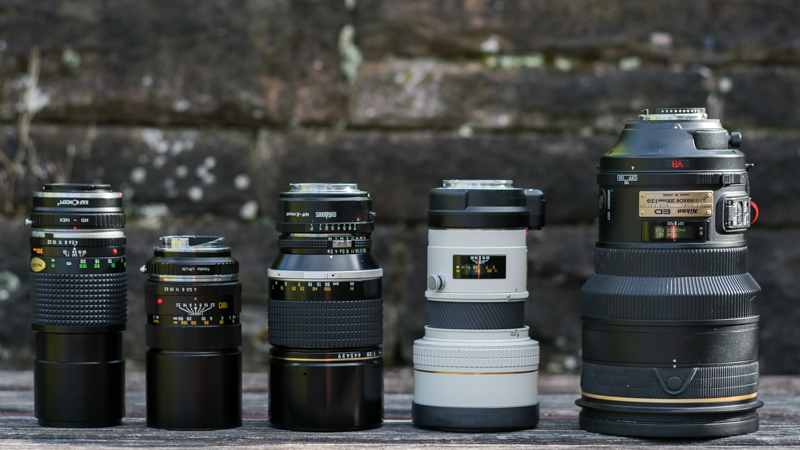
We have gathered 180/200mm primes ranging from f/4.0 to f/2.0 with used prices between 40$ and 3000$ and put them up against each other on the 42mp A7rII. Read on to find out more about our findings!
Unlike my other reviews this is a pretty technical comparison without real world shots. Apart from that I have only used some of the lenses for a few days.
Specifications
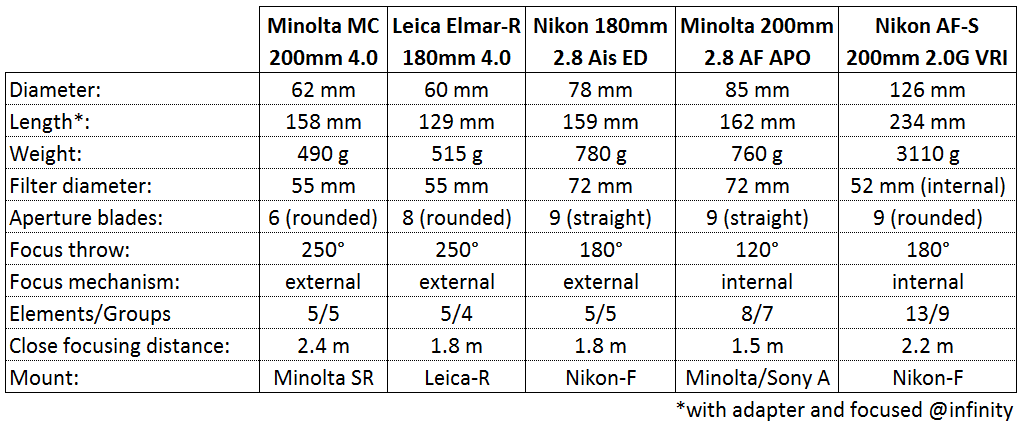
Used prices:
Minolta MC 200mm 4.0: 40$/60€ @ ebay.com/ebay.de
*
Leica-R 180mm 4.0: 350$/300€ @ ebay.com/ebay.de
*
Nikon Ai-s 180mm 2.8 ED: 350$/350€ @ ebay.com/ebay.de
*
Minolta AF 200mm 2.8 APO: 550$/750€ @ ebay.com/ebay.de
*
Nikon AF-S 200mm 2.0G VRI: 3500$/3000€ @ ebay.com/ebay.de
* (very rare)
Adapters I have used:
K&F Concept MD-NEX: 14$/21€ @ amazon.com/amazon.de
*
Fotodiox L/R-Sony-E: 22$/37€ @ amazon.com/amazon.de
*
Metabones Nikon-G to Sony-E: 135$/160€ @ amazon.com/amazon.de
*
Sony LA-EA4: : 350$/225€ @ amazon.com/amazon.de
*
*affiliate links
Handling / Build Quality
Minolta MC 200mm 4.0:
I don’t like the very long focus throw as I can’t get from infinity to the minimum focus distance in one turn. There is very little way between f/4.0 and f/8.0 and I found it somewhat hard to set the desired aperture without looking at the lens, but this may a problem of this very sample. Out of the 4 lenses with telescopic hoods in this comparison this is the one I like most as it is not wobbly and snaps into place (probably because of a magnet).
Leica-R 180mm 4.0:
I don’t like the very long focus throw as I can’t get from infinity to the minimum focus distance in one turn. The focusing ring is just a tad on the stiff side but otherwise feels very nice. The hood is not wobbly but does not snap into place as on the MC. What I really like about this lens is that it is the smallest of the bunch.
Nikon Ai-s 180mm 2.8 ED:
Focus throw and resistance of the focusing ring are excellent. The hood is a bit on the wobbly side but also snaps into place because of a magnet. The aperture ring is the best in this comparison, but this may also be due to the fact this lens hasn’t been used much. Handheld I don’t really like this lens on the A7 bodies as it is a very front heavy lens (this gets worse on focusing closer) and quite thick.
Minolta AF 200mm 2.8 APO:
This is actually unlike any other lens I have used before. The hood is extendable but you need to turn it a bit to tighten it. When using the LA-EA4 adapter the narrow focusing ring always rotates during focusing operations (the throw is also too short for a nice manual focus experience). What is very special: there is retractable cowling to cover the focusing ring and a ring for adjusting the focus limiter. The AF is very fast with the LA-EA4.
Nikon AF-S 200mm 2.0G VRI:
I have used this lens handheld for a few weddings with my D800 but this clearly isn’t something anyone would do voluntarily for a longer period of time. The very big focusing ring makes setting the focus precise quite easy. There is also no slack in the focusing ring when changing the direction of rotation inherent in many other AF-S lenses. I am also really interested in testing this lens with the Commlite AF-adapter but didn’t yet get the chance to do that. On Nikon DSLRs this is the fastest focusing (and battery draining) lens I have used so far.
Sharpness
infinity
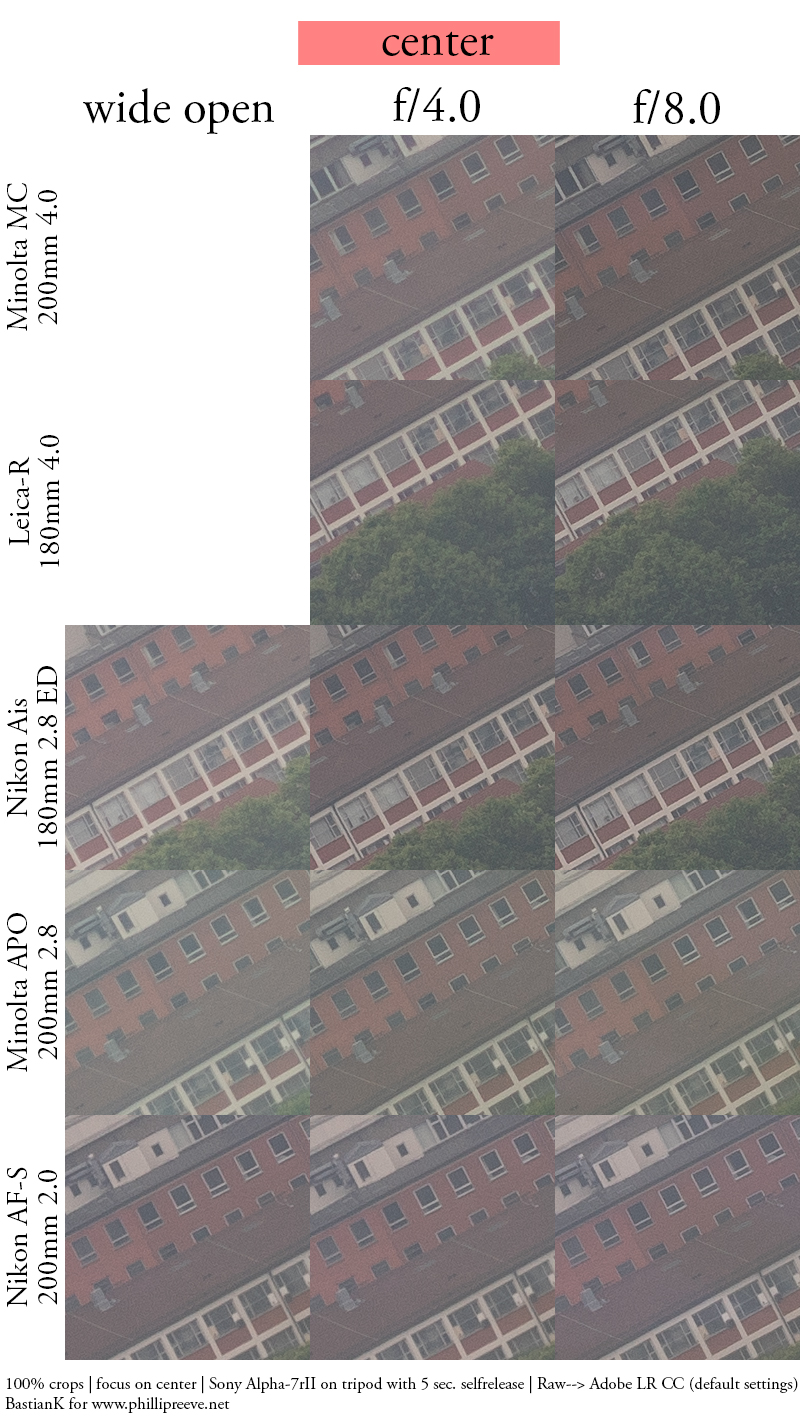
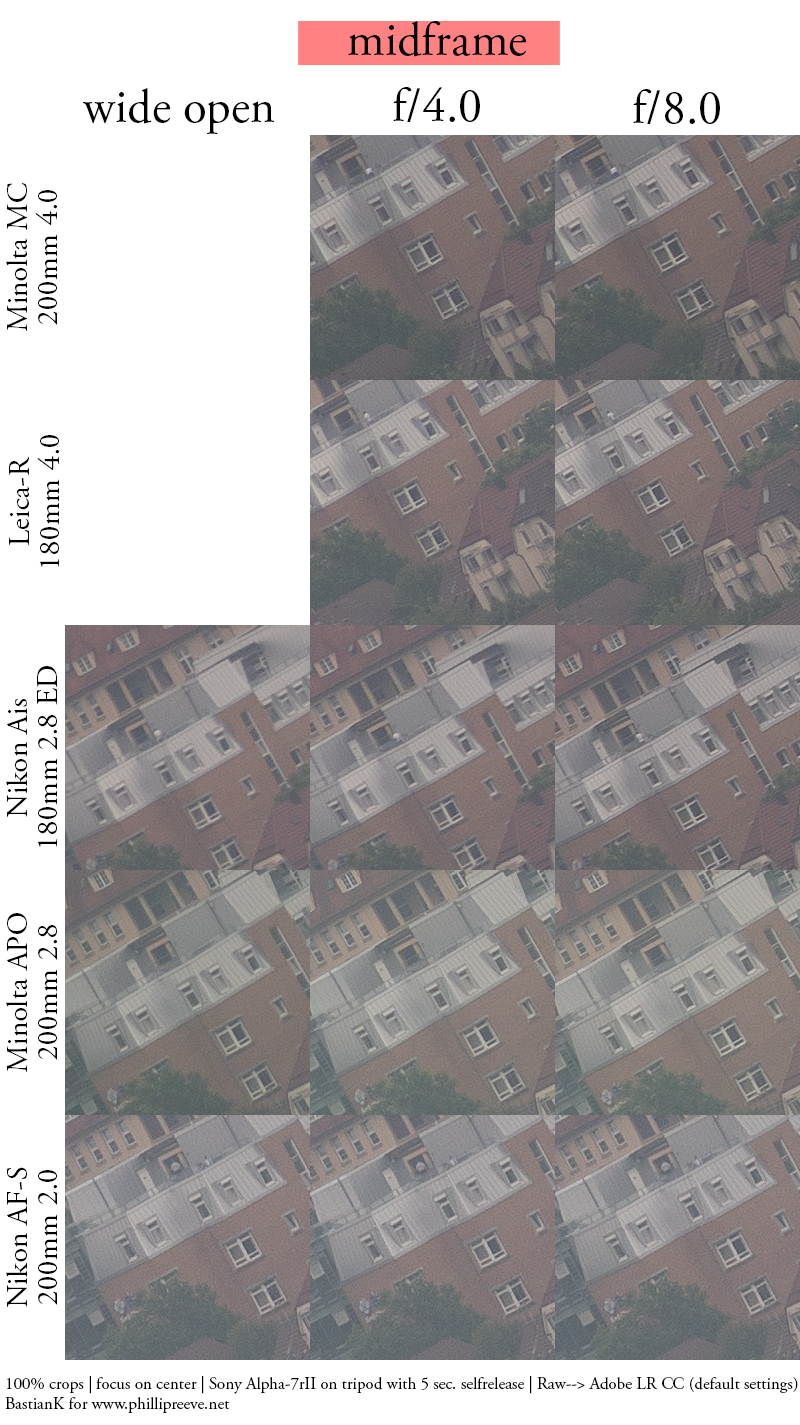
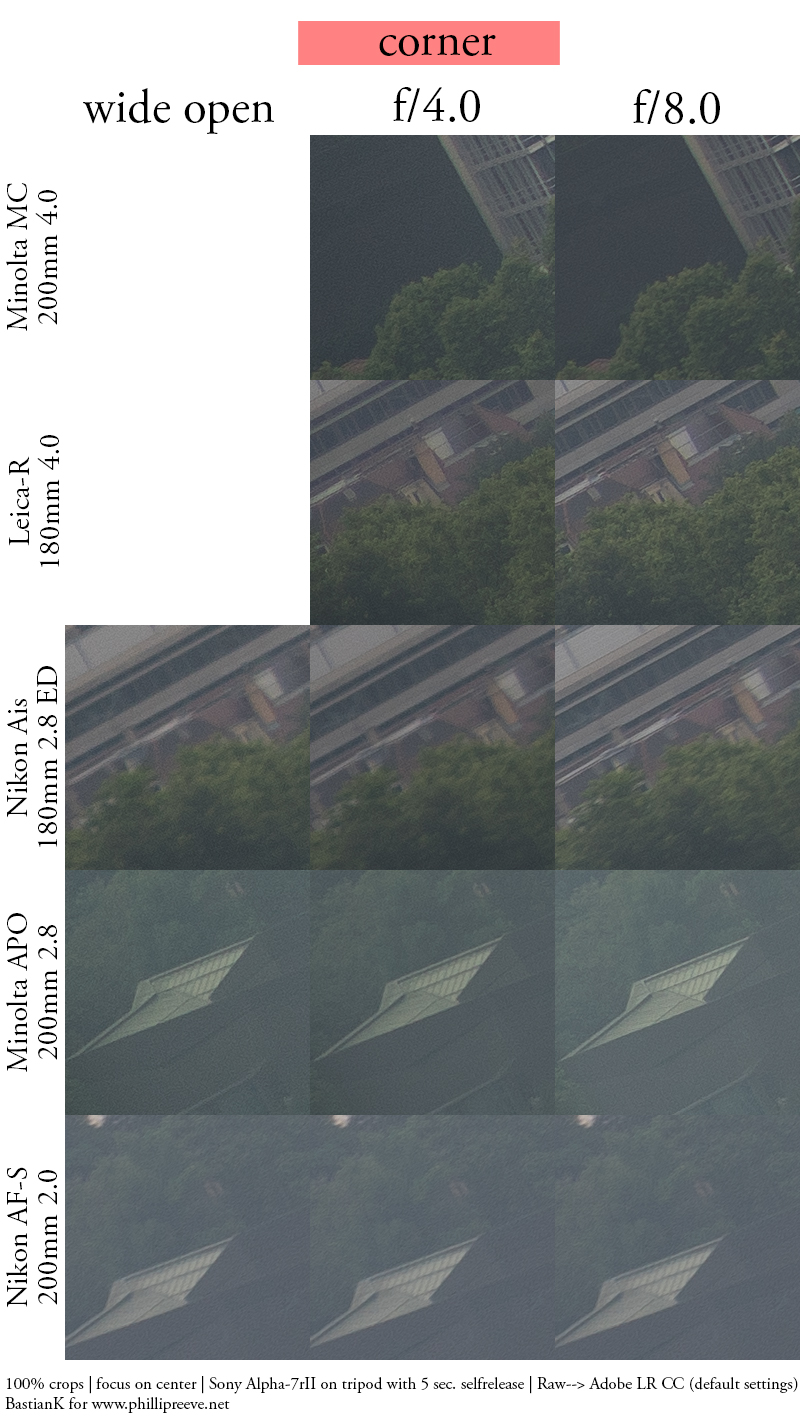
The exposure on some of the corner crops has been adjusted in post. Focus was done wide open for the center of the image so no correction for focus shift or field curvature was performed.
All lenses are pretty good in the center and the midframe, even wide open. In the center I see a slight edge for the 200mm 2.0.
In the corners the Nikon 180mm 2.8 really struggles, even stopped down, and the Minolta 200mm 2.8 APO looks best to me.
2.5 m
Wide open the 200mm 2.0 might have a small edge here and the 180mm Nikon and the 200mm 4.0 Minolta look worst to me. Stopped down they all look at least very good to me.
Bokeh
wide open
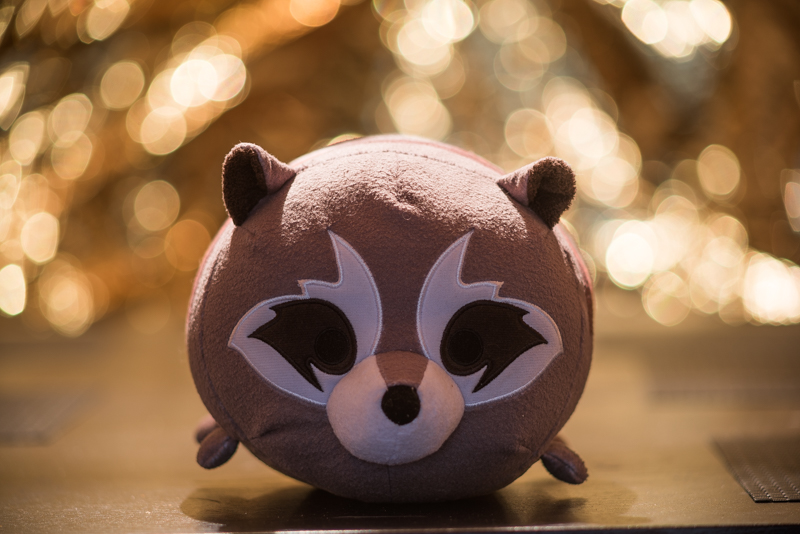


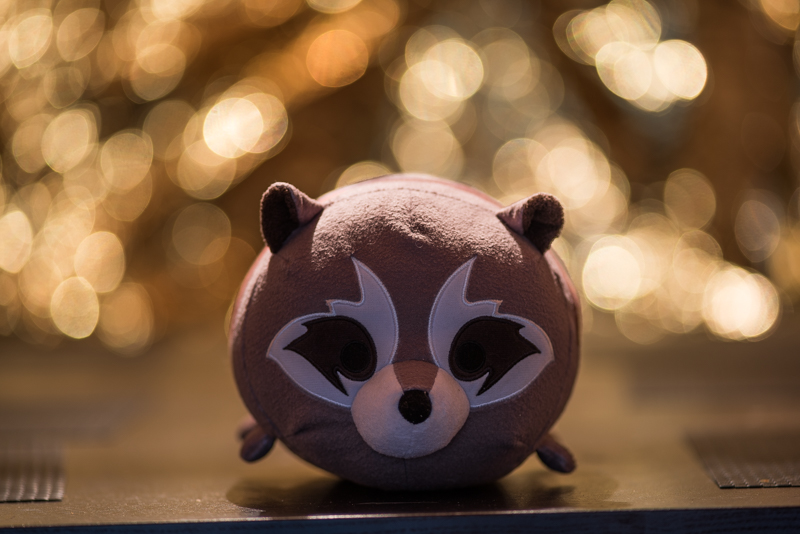
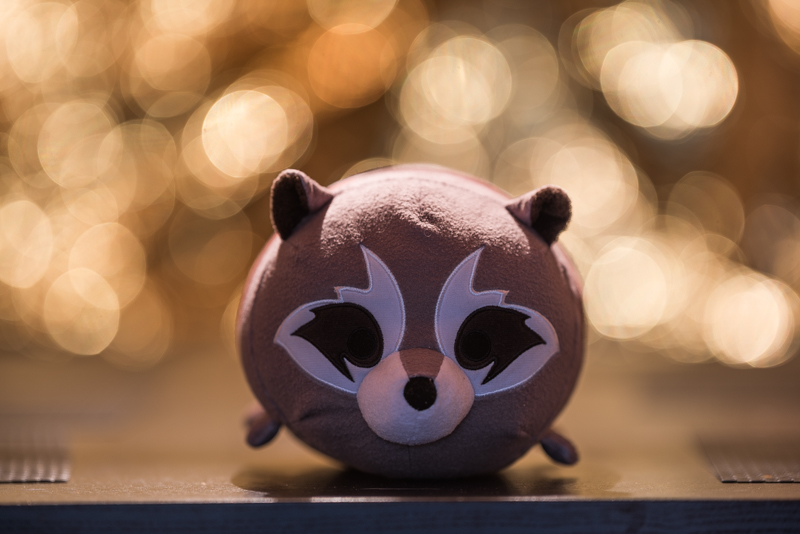
No suprise: wide open the 200mm 2.0 is in a league of it’s own here and the differences are pretty imminent as the light circles are substantially and easily visible bigger compared to the competition.
I don’t really like the f/4.0 lenses here, but not only because of smaller light circles but because of the green outlining you can see with both lenses. The Minolta MC is the worst here in my eyes as it also shows the worst mechanical vignetting I have seen so far. Here we are not talking cat’s eyes anymore but merely salad bowls.
The Nikon 180mm 2.8 and the Minolta 200mm 2.8 APO both look quite similar and also very pleasing to me.
@2.8


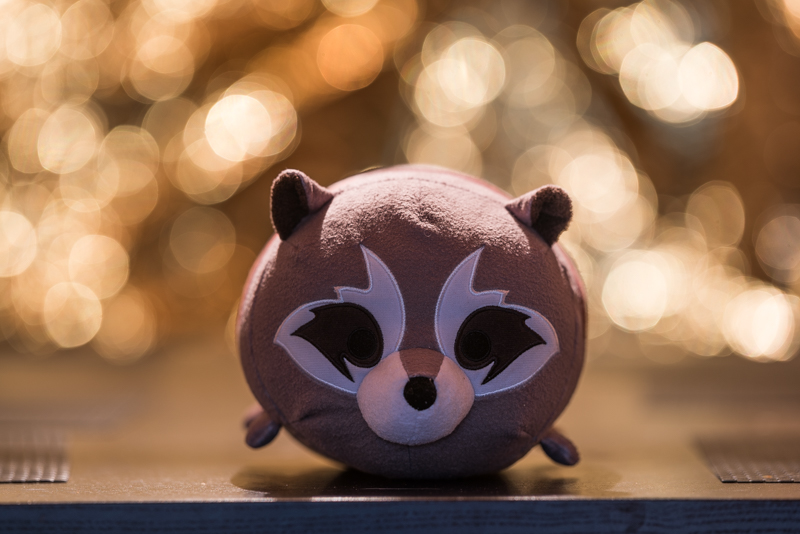
As it is already stopped down the 200mm 2.0 shows the least mechanical vignetting here and thanks to 9 rounded aperture blades the light circles pretty much stay circles.
@4.0




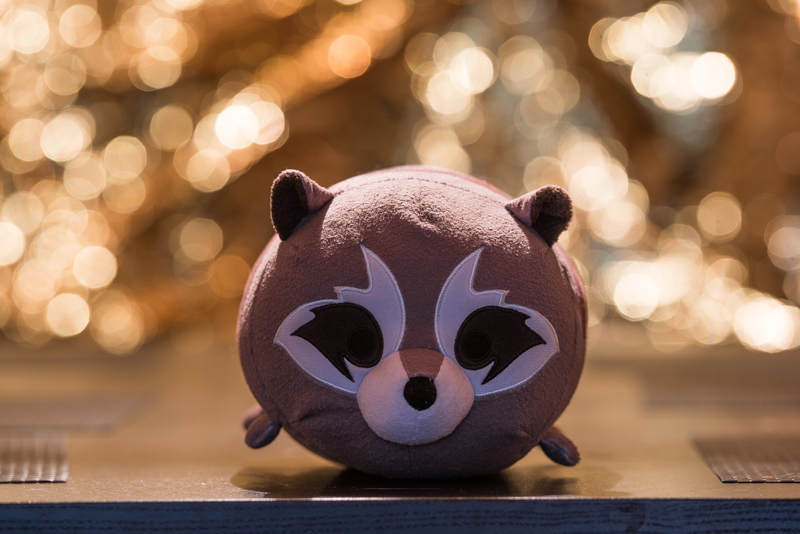
The Nikon 180mm 2.8 and the Minolta 200mm 2.8 both have 9 straight aperture blades so the highlights become 9 sided figures. The 200mm 2.0 with it’s rounded blades still produces pretty much round highlights.
@8.0
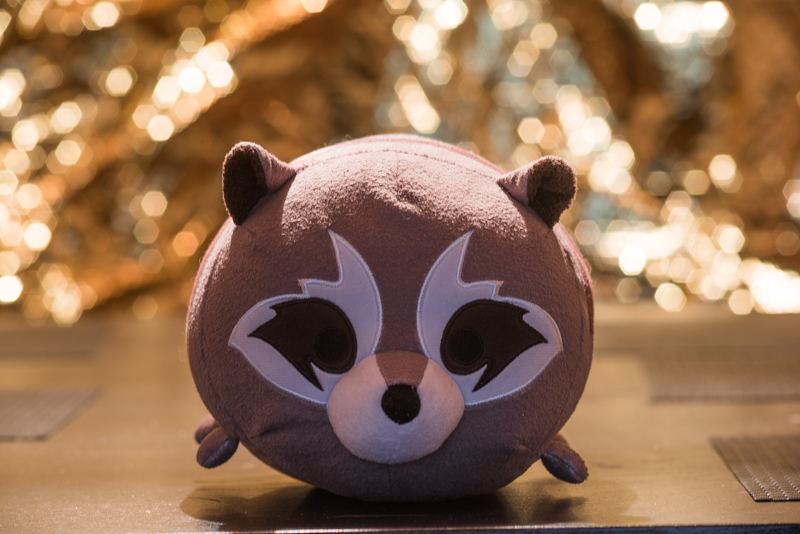
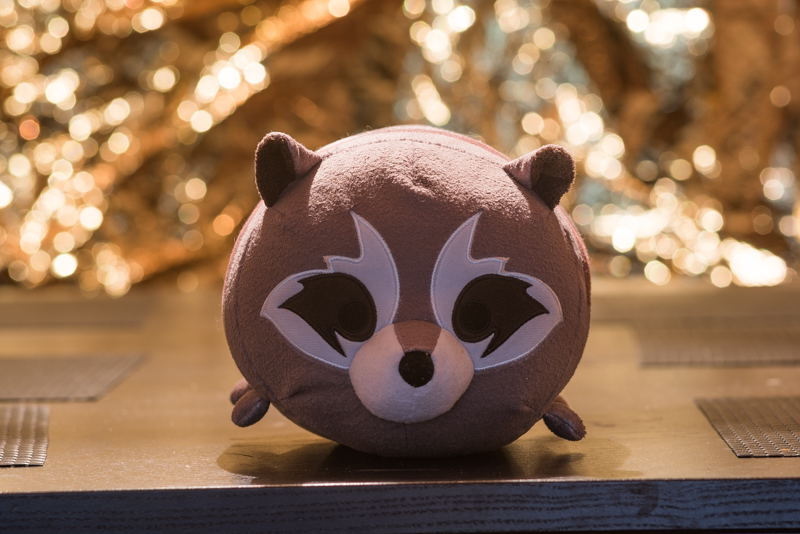

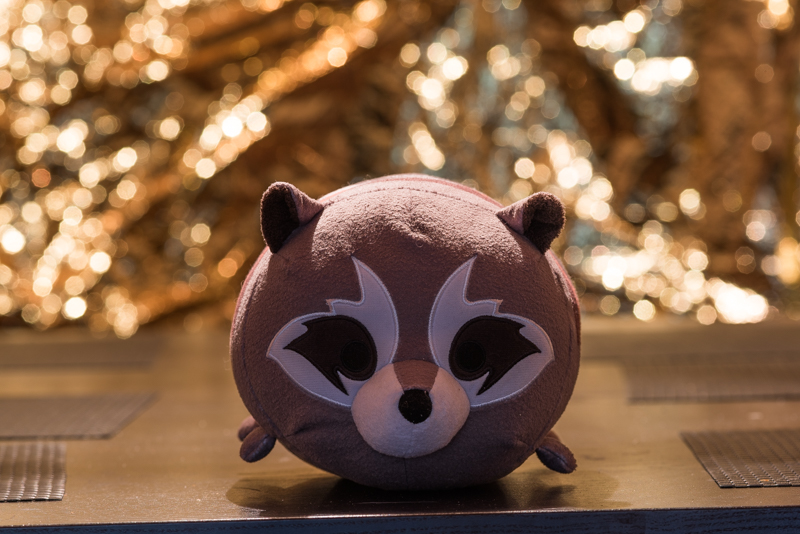

Here we have a nice comparison of how different diaphragm constructions influence the shape of out of focus highlights. The MC 200mm 4.0 produces hexagons, the Leica 180mm 4.0 octagons and the other three 9 sided figures.
Chromatic Aberrations
longitudinal

The f/4.0 lenses once more don’t look really great here. The Minolta 200mm 2.8 (even carrying an APO tag) shows noticeable color fringing as well. Together with the Nikon 180mm 2.8 these 4 lenses look pretty similar here but the 200mm 2.0, despite being the fastest and therefore most difficult to correct, hardly shows even traces of color fringing and I am tempted to say this is one of the few truly apochromatic lenses.
Conclusion
It was very interesting have these four very different lenses side by side (not so much fun carrying all around at once 🙂 ).
The f/4.0 lenses are smaller and lighter than the rest and offer decent sharpness across frame even wide open, but I found the bokeh rather lacking and the minimum focus distance of the MC 200mm 4.0 is quite the show stopper for me, as is the diaphragm with only six blades. But for the used prices you can hardly go wrong as there are more expensive paperweights available.
I can’t say the Leica-R is really worth the used prices in comparison as it only offers a little more for much more money.
The Nikon Ais 180mm 2.8 ED has very nice bokeh and central/midframe sharpness but the corner sharpness at infinity isn’t really something to write home about. If you plan on using this lens for portraits I can recommend it. If you plan on using it stopped down for landscapes: not so much.
The Minolta AF 200mm 2.8 APO is a very interesting lens. The sharpness is excellent across frame even wide open. I have some problems with the APO tag though. In terms of longitudinal chromatic aberrations this is pretty much in the same league as the aforementioned lenses. The mechanics also feel a little bit dated, a focusing ring which rotates during AF operations is clearly not something I like (albeit the AF is pretty fast with the LA-EA4). The used prices are pretty high nowadays but it is hard finding a better 200mm 2.8 (haven’t tested the EF 200mm 2.8 though, yet)).
The Nikon AF-S 200mm 2.0G VRI is clearly a special purpose lens designed for tasks like shooting indoor sports but is also known for it’s astonishingly beautiful bokeh which led some people to use it for portraits as well. This is also pretty much an apochromatic lens and sharpness (center/midframe) as well as contrast are also excellent. The problems here are price and especially size and weight. I have hauled around this lens in Yosemite national park and also used it for some shots in Iceland but it simply is a pain carrying it around and airline companies are it’s natural enemy.
These lenses are all very different instruments for different tasks. Know your task and it becomes clear which lens is the right choice for you.
Further Reading
- Leica Summicron 90mm 2.0 pre Asph Review
- Voigtlander 10mm 5.6 Hyper Wide Heliar Review
- Canon nFD 135mm 2.8 Review
Support Us
Did you find this article useful or just liked reading it? Treat us to a coffee!
![]()
![]()
![]() via Paypal
via Paypal
This site contains affiliate links. If you make a purchase using any of the links marked as affiliate links, I may receive a small commission at no additional cost to you. This helps support the creation of future content.
Latest posts by BastianK (see all)
- Review: Viltrox AF 35mm 1.2 FE LAB - December 17, 2025
- Analogue Adventures – Part 47: Tübingen - December 17, 2025
- Review: Zeiss Milvus 25mm 1.4 Distagon - December 13, 2025
too bad you didn’t include the CY Zeiss 200mm – did the guy who offered not come through? I could have supplied one as well
Thanks so much for this comparison Bastian, I may just consider trying the 2.8 APO.
I’d just like to point out that ‘handholding’ is an expression I’ve never heard before, the typical expression is ‘handheld’.
I don’t mean to sound like a snob, I know English isn’t your first language. It is the fact that it is 99.99% perfect that I want to help you make it 100%
I was also going to bring up what I thought was the incorrect use of ‘showstopper’, but I looked it up and you were using the American definition. It is logical of course, something which stops a show is obviously bad, but in nonsensical British English, a showstopper is something so good it receives so much applause that the show cannot go on. Just thought you might find that interesting.
Thank you for your feedback!
Bastian
Hi Bastian,
I’ve been lurking here for some time. Just to say that I really appreciate your reviews and you’re a favourite site of mine for “legacy” stuff. My wallet probably doesn’t like you a lot 🙂 but this is clearly a sign of your good job, since sometimes you make me willing to buy something. 😉
PS In the header of the first column of the table, the Minolta MC 200mm is marked as “2.0” instead of “4.0”. For a few seconds I was puzzled at how they managed to make it with a 55mm front element 😉
Thanks for your feedback and especially pointing out that mistake, will of course correct this!
Bastian
Thanks for this nice comparison.
The 200 2,8 APO is a bit awkward mechanically, especially if your fingers like to slide the cowling back unintentionally, but it’s significantly more pleasant than the 2,5kg 300 2,8 APO which has the same kind of external layout.
I’m also interested in the EF 200 2,8, it almost seems to reside in the shade a bit in Canonland.
I am using the EF 135mm 2.0L for portraits a lot and with the 42mp I can easily crop out what a 200mm 2.8 would give me, this is the only reason I haven’t bought one (yet 🙂 )
Bastian
Hi,
Thanks for the comparison 🙂
Do you know how is the Canon fd 200mm f/2.8 compared to the rest?
Thank you !
Dear Bastian,
Thank you for the review! I’m curious why both Nikkors did quite poor in the corners. Is there anything to do with the adapters? Seeing a Nikon supertele struggle in resolution simply haunts me…
Adapters may always have a (bad) influence on the image quality, but with tele lenses I didn’t experience huge impacts by now. Looking at the MTF of the 200mm 2.0 I wasn’t so suprised by the results either.
Bastian
Thank you for the comparison. I own the Minolta HS AF 200mm/2.8 (with an optional 1.4x MF converter), the Nikon AF 180mm/2.8 and read about the pricey Nikon 200mm/2 in a forum.
So I was interested to read a direct review of these.
Besides the tag ‘APO’ I see a lot of reviews of older lenses who show more CAs like Zeiss 135mm Sonnar-APO than modern ‘normalos’ (Samyang).
Is there an older Zeiss 135 APO Sonnar ?
You cannot be speaking about the new one, as its CA correction is exemplary. Probably the best 135mm lens ever made.
Yes, the Zeiss 135mm APO Sonnar.
“While lack of CA should be main selling point of the Zeiss APO design, in reality (and I noticed that in a real life shooting too), lens rendering is not entirely CA free. It shouldn’t be a problem in 99.9% scenarios, but non APO Samyang is in fact slightly better in that regard.”
Quote from http://www.verybiglobo.com/zeiss-apo-sonnar-135mm-f2-zf-2-review/3/
Yes, the Samyang seems also very well corrected for CA, but the difference is minimal and possibly caused by the fact that the absolute aperture is slightly smaller.
I haven’t shot with the Samyang 135, but from the several example pictures it seem to have the same warm yellowish color cast present in many of their recent lenses.
Some users like that color cast, and others think the color cast can be easily fixed with some post processing. Unfortunately, I am not one of them. I guess everyone is diferent 😉
Regarding the color rendition of the Samyang 135mm: Count me in here, too 🙂
Bastian
Excactly why the Leica R 180mm/3.4 is no lens for me because of the limited near range abilities.
The yellow cast of a lens wouldn’t bother me.
You got the “wrong” Leica 180 🙂
The “real” Leica 180 is the APO Telyt-R 180/3.4.
For the price, it crushes all other lenses but the 200/2 monster.
But hush… don’t tell anybody, or used prices will go up 🙂
To put it mildly the bokeh of the APO Telyt-R 180/3.4 is unruly
Yes, bokeh can be harsh in some shots, depending on subject distance.
Keep in mind that the lens is optimized for far subjects, and not the best choice for close portraits also because MFD=2.5m.
Other than that, the lens delivers an excellent image quality in a very small and portable package, thanks to its essential design and amazing APO glass. Real APO glass.
Thanks for reminding us of the APO Telyt-R 180/3.4. I had forgotten to watch out for this.
Doe you happen to know the Telyt’s true focal length? (I have noticed in some of my lenses a significant difference of true focal lengths relative to claimed focal lengths.)
I am considering this lens for landscapes when backpacking (A7r2), but I want it to be different enough in focal length from my manual 135mm lens (probably either Zeiss 135mm f/2 APO-Sonnar ZE or Sony A-mount STF).
Hello, very nice review and indeed like the minolta 200mm f4
But just curious, could you say how the Leica-R 180mm 4.0 performs regarding coma (wide open).
I’m considering because of the compact construction.
Would like to use them for some astrophotography as well in combination with the Polarie. Had some mixed results with the Minolta and think it’s due to imbalance of the combo (rather long lens).
And how is the APO Telyt-R 180/3.4 regarding coma.
The 180/3.4 is very well corrected for coma. Many astrophotographers use it, especially because of the APO performance and optimization for infinity.
Any idea about the Leica-R f4 ?
Would prefer this lens because the weight and size
Pity the MInolta MD 200 mm f 2.8 was not included (700 g, same length as the f4.0)… but sure enough, there are too many lenses so ou could not include them all.
Excellent job s usual.
Here’s another option: the Pentax -A 67 200mm f.4.0. This is an adaptable medium format lens with just superb build quality and handling (it’s girth-y, though). It is compact for its genre and its weight is almost identical to that of my Nikkor 180mm f.2.8 ED at around 27 ounces. The adapter will add a bit more weight and length than is usual for smaller format cameras, but this takes on a better aspect when you consider that the Pentax 67 (grey) 1.4x teleconverter actually adds some plainly intended correction to an already very well sorted out lens — a “dedicated”, though versatile, TC accessory, in effect.
In short, “two very beautiful lenses in one”, 200mm and 280mm! I know of nothing else quite like this surprisingly practical combo. The TC is weighty, though, at around 500 grams; but that can be carried separately in a belt pouch, so it won’t really be so burdensome. Given the high level of combined correction and the huge image circle thrown, stacking another 1.4x TC for potentially very good results at 392mm is a distinct possibility, I’d think. I haven’t had the chance to experiment yet.
This lens combo is joined here by the aforementioned Nikkor and its 200mm f.4.0 AI-S brethren, plus the super compact and economical SMC Pentax-M 200mm f.4.0 for its convenience factor. I’d love to see a test of the f.4.0 AI-S Nikkor thrown into this mix, Bastian. Thank you for all your fine work here.
Hi.
Thanks for the review, I always read your reviews with interest:)
The one telelens which I could add is carl zeiss jena 180/2.8 or CZJ 200/2.8. They produce great bokeh and cost 75-150$. The downside is that they are big medium format lenses but have good reputation.
An apochromatic lens simply means that three wavelengths of light are brought into common focus. An apochromat does not mean that it is entirely devoid of chromatic aberrations, nor does it guarantee much about how out-of-focus things look — although it is often a pleasant side-effect that they are better corrected for all forms of chromatic aberrations. Nonetheless, it seems that most manufacturers do not care about the true definition of the word, and instead slap the “APO” prefix onto lenses as a marketing gimmick.
By the way, talking about truly apochromatic lenses, I would love to see a review of the Voigtlander APO-Lanthar 180mm f/4 SL. The Voigtlander APO-Lanthar SL series of lenses (not to be confused with the APO-Lanthars for the rangefinder mounts) are known to be very excellent, of which the 125mm f/2.5 is the best. Unfortunately the Voigtlander 125mm and 180mm are very rare and expensive nowadays, but here is Ming Thein’s glowing review of the 180mm:
https://blog.mingthein.com/2015/03/06/review-of-a-rare-bird-the-voigtlander-1804-apo-lanthar/
Good review for a down and dirty expose on the needed intel for CA, sharpness, etc. If you do another, would the Takumaer SMC 200/4 be a candidate? And maybe a Russian or East Germany model, since you are doing vintage glass?
Spitzen Vergleich!! Besonders im Hinblick auf das ED 180 was ich mir noch besorgen möchte. Hätte noch das 180mm 2,8 Olympus beizusteuern, das ist in Sachen Schärfe bei Offenblende unvergleichlich und hängt das Minolta 200mm APO 2,8 und das Canon FD 200 2,8 ab. Leider hat es starke Lila Säume bei Kontrastkanten
I like the 180/200mm focal length so have a couple of options in that range. The Tamron SP 180mm f2.5 is one of my favourites, and a well known lens. The other, less well known, (non-zoom) 200 that I really like is the SMC Pentax-FA* 200mm F2.8 ED [IF] (I had to look up the ‘official’ name, which is a bit of a mouthful!) Nice build, push-pull focus clutch works very nicely, good hood, and the sharpness, colour and bokeh all appeal to my eye very well. It’s also, price wise, a bit of a ‘sleeper’ these days.
Really wish zeiss would come out with 180 or 200 milvus 2.4 or 2.8. Right now in this focal range you have legacy primes, modern zooms, and the f2 extraordinary large and expensive primes. The closest thing to a high performance modern 180/200 that I am aware of is leica r 180 APO 2.8 and costs in the same range as the autofocus f2 primes.
A new milvus 180 APO sonnar that plays in the same league as the 135 would be just awesome!
Interesting. The price of entry with these lenses is much wider than the over all image quality in my book.
I have used several fixed 200mm lenses and zooms in that range. Now that I am a (mostly) Sony A7 shooter I am playing with several options. One of which is a really nice condition Minolta MC Rokkor 200/3.5 w/ metal grip and built in hood. Purchased used locally for $35. Very nice lens for that price but I am sure there are stronger performs out there but at what cost?
Perhaps the best 200 I have used and enjoyed was the now very rare and great Pentax A* 200/2.8 ED.
This was an interesting post to me (many years ago), so thanks Philip (I think . . . )
I have had 3 of the 5 I think. The minolta f4 (hated it, too long, not sharp enough), the Elmar-R (2 copies) liked the size, too long, too heavy.
Minolta f2.8 APO- currently selling for the Canon f2.8. The LA-EA4 was never good (Af not up to scratch and loss of a stop a waste). I watched the LA-EA5 come out and it seemed like finally a way for my minolta 200mm and 50 1.4 to shine. I was getting an A7siii, selling the D3 and keeping the A7s as a second (small body). But the LA-EA5 doesn’t work with the A7siii and with the A7s won’t even give basic AF.
I decided to swap my AF 200/50mms for the canon versions and the metabone works phase detect on the A7siii and basic AF on the A7s. The canon is lighter than the minolta too. I would much rather have kept screw drive lenses but I gave up.
I also got the VM 180mm f2 APO lanthar- manual focus but amazing and I love the 180mm length rather than 200. People say its basically the same but it really isn’t to me. The canon 200 seems to be a hair shorter than the minolta too. I use the VM as a macro lens a lot too.
I have really struggled to replace a beloved Nikon 180mm f2.8 AF-D but it was impossible to convert to sony, or even mirorless Nikon with AF.
The big viewfinder on the A7siii seems to make MF easier, so I think the VM will stay, probably the canon too as the f2.8 AF option.
Dear Bastian,
thank you. Would you check da Leica 180/2 APO Summicron-R, this is so great not only to artists’ hands and eyes.
I own one good copy and I am so happy with it.
Chris
I would love to review it, but unfortunately I cannot spend 8.000 Euro to get one just to write a review 🙂